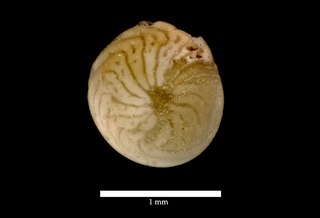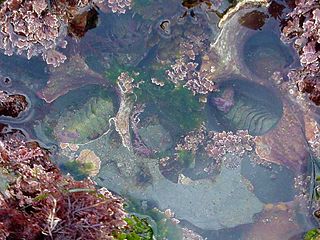Carterina is a genus in the Foraminifera. It is the only known genus of the order Carterinida and family Carterinidae. The type species is Carterina spiculotesta Brady, 1884. The genus is described from specimens gathered during the Challenger expedition's circumnavigation of the Earth from 1872-1876.
The Nodosinellacea is a superfamily of fusulinds in which the test is of one or more distinct chambers with the wall single layered or with a microgranular outer layer and fibrous inner layer. Differs from the Geinitzinacea in that the latter has the layers reversed.
The Geintizinacea comprises a superfamily of Upper Devonian to Upper Permian uniserial fusulinids, the chamber walls consisting of a dark microgranular inner layer and radially fibrous outer layer. Advanced forms show secondary lateral thickening
The Fusulinidae is a family of fusulinacean foraminifera from the upper Carboniferous to the Upper Permian (Guadalupian), tests of which are fusiform to subcylindrical with walls of two to four layers. Are planispirally coiled throughout or with early whorls at a distinct angle to the later plane of coiling. Septa, flat to well fluted; tunnel, single; chomata variable in development.
Verbeekinidae are large fusulinaceans characterized by subspherical to cylindral, planispirally coiled tests; long axis the coiling axis. Wall is composed of a dense outer tectum and inner, alveolar keriotheca.
Acervulinacea is a superfamily in the Foraminifera order Rotaliida. The Acervulinacea may be free, or able to move about, or their tests may be attached to some substrate. The early growth stage is spiral, followed by irregular chambers that form an irregular mass, disc, or branching structure. The test wall is of hyaline (glassy) optically radial calcite and is coarsely perforate. Apertures are present only as mural pores.

Globigerinoidea is a superfamily of free-living, calcareous, planktonic foraminiferal protists that have lived in the open ocean since the Eocene. It is part of the suborder Globigerinina.
Lagenida is an order of benthic foraminiferal protists in which the tests (shells) are monolamellar, with walls composed of optically and ultra-structurally radiate calcite, with the crystallographic c-axes perpendicular to the surface. Lagenids first appear in the Upper Silurian and continue to the Recent. They are currently divided into two superfamilies, the older Robuloidacea which range from the Upper Silurian to the Lower Cretaceous (Albian) and the younger Nodosariacea, ranging from the Permian to Recent.
Nodosariacea is one of two superfamilies making up the foraminiferal order Lagenida. The other being the Robuloidacea. Of these two Nodosariacea is the more advanced, as well as being the younger.
The Robertinida are an order of Middle Triassic to recent, benthic foraminifera in which tests are planispirally to trochospirally coiled, with chambers provided with an internal partition and hyaline perforated walls composed of optically radiated aragonite.
Discorbis is a genus of benthic Foraminfera, that made its first appearance during the Eocene. Its present distribution is cosmopolitan.
Rosalina is a genus of foraminifera included in the rotaliid family Rosalinidae.
Neoconorbina is a genus of recent (Holocene) discorbacean foraminifers related to Rosalina with a low conical trochoidal test, circular in outline. The conical side is the spiral side, on which all three whorls are visible, the final chamber taking up most of the periphery. The umbilical side is flat to concave. exposing only the three to four chambers of the final whorl around an open umbilicus. Chambers on the umbilical side have triangular to platelike umbilical extensions as with other rasalinids. The wall of is calcite, finely and densely perforate on the spiral side, more coarsely perforate on the umbilical side; surface smooth; aperture at the umbilical margin of the chamber, beneath the platelike extension, or folium.
Astrononion is a genus of foraminifera in the family Nonionidae, characterized by an evolute planispiral test with radially stellate structures partly covering the sutures on either side. The test is free, bilaterally symmetrical; periphery broadly rounded; chambers distinct, separated by depressed radial sutures, increasing gradually in size, and usually inflated; aperture a low arched opening at the base of the face of the test. The wall is of finely perforate monolamellar granular calcite.
Guttulina ,Guttulina (Guttulina), is a genus of nodosariacean forams belonging to the Polymorphinidae and subfamily Polymorphinidae. The test is ovoid to elongate, inflated chambers added in a quinqueloculine spiral series, 144 deg. apart, each successive chamber extending further from the base but strongly overlapping. Sutures depressed, aperture radiate. As with all Nodosariacea the wall is of finely perforate, radial laminated calcite.
Favocassidulina is a foraminiferal genus; rotaliid family Cassidulinidae, known from the middle Miocene to recent in the Indian and Pacific oceans. Its habitat is benthic, near shore.
Schwagerina is an extinct genus of fusulinacean Foraminifera that is used as an Early Permian index fossil. The overall shape of the shell or test is fusiform to subcylindrical, the spirotheca, or outer test wall, is thick, and composed of tectum and alveolar keriotheca; the septa are fluted throughout the length of the shell, intense to top of chambers in some, only in lower parts in others; axial fillings highly variable, chomata distinct or thin and discontinuous.
The Globoroatioidea constitutes a superfamily of Cenozoic plantonic foraminifera. It is part of the suborder Globigerinina. Globoroatioidea have trochospiral tests with rounded to carinate peripheries, the walls of which are of finely lamellar, perforate, of optically radial calcite, with an inner organic lining. The surface of these tests is smooth, lacking spines, but may be covered with pustles or pitted, and may have one or more large pores at the center. There is a single primary aperture that may be bordered by an imperforate lip, as well as possible supplementary apertures.

Amphistegina is a genus of foraminiferal protists included in the Rotaliida with a stritigraphic range extending from the Eocene to recent and a cosmopolitan distribution. The test is an asymmetrically biconvex trochospiral that may be bi-involute or partially evolute on the spiral side. Chambers are numerous, broad. and low, strongly curved back at the periphery to form chamber prolongations. The umbilical side is stellate, like that of Asterigerina, and has a distinct umbilical plug. The wall is calcareous, optically radial; the surfacce finely perforate and smooth overall. The periphery angular to carinate (keeled); the aperture an interiomarginal slit on the umbilical side, bordered by a lip.
Alfred R. ("Al") Loeblich Jr (1914–1994) was an American micropaleontologist. He was married to Helen Niña Tappan Loeblich and the two co-authored a number of important works on the Foraminifera and related organisms.
Helen Niña Tappan Loeblich was a leading micropaleontologist, a professor of geology at the University of California, Los Angeles, a United States Geological Survey (USGS) biostratigrapher, and a scientific illustrator whose micropaleontology specialty was research on Cretaceous foraminifera.
The Treatise on Invertebrate Paleontology published by the Geological Society of America and the University of Kansas Press, is a definitive multi-authored work of some 50 volumes, written by more than 300 paleontologists, and covering every phylum, class, order, family, and genus of fossil and extant invertebrate animals. The prehistoric invertebrates are described as to their taxonomy, morphology, paleoecology, stratigraphic and paleogeographic range. However, genera with no fossil record whatsoever have just a very brief listing.




